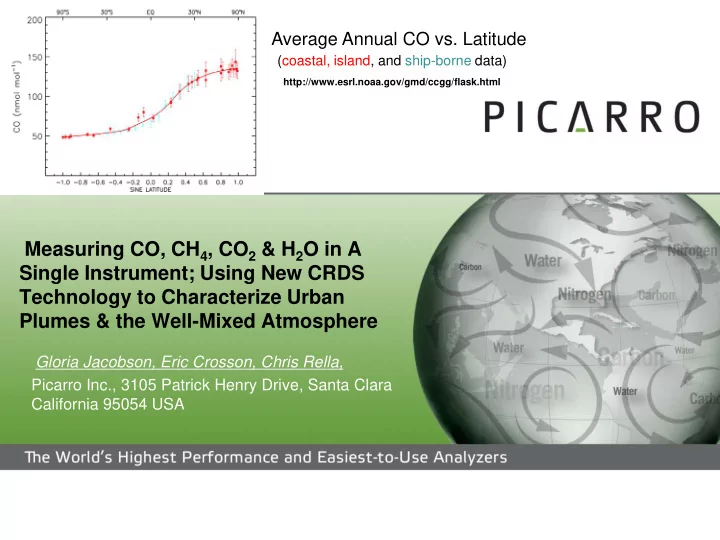

Average Annual CO vs. Latitude (coastal, island, and ship-borne data) http://www.esrl.noaa.gov/gmd/ccgg/flask.html Measuring CO, CH 4 , CO 2 & H 2 O in A Single Instrument; Using New CRDS Technology to Characterize Urban Plumes & the Well-Mixed Atmosphere Gloria Jacobson, Eric Crosson, Chris Rella, Picarro Inc., 3105 Patrick Henry Drive, Santa Clara California 95054 USA
Experiment Motivation • What information can be gained from “rooftop” (10m or lower) measurements made in dense urban settings? • In particular, a) Do nearby sources (e.g, vehicles) dominate the measurements? b) Can you partition anthropogenic and biogenic emissions of CO 2 using measurements of CO? c) Can you quantify source locations and/or temporal behavior? 2
Experimental Set Up H1 (32 ft) V1 4 Species Analyzer CO, CO 2 , CH 4 , H 2 O H2 (22 ft) V2 H3 (10 ft) V3 Reference Cylinder Picarro Flagpole 3
4- Species Analyzer • Measures concentrations of CO, CO 2 , CH 4 , & H 2 O • Measures all 4 species w/in 5 seconds • Meets precision spec (1-sigma of 5 min avg) – CO < 2 ppb – CO 2 < 50 ppb – CH 4 < 0.7 ppb – H 2 O < 50 ppm • Automatically corrects & reports dry mol fraction • Instrument was calibrated once prior to experiment 4
Zoom In on Time Series Sampling Scheme 1. Bottle (6 min) 2. H1 (4 min) 3. H2 (4 min) 4. H3 (4 min) 5. H1 (4 min) 6. H2 (4 min) 7. H3 (4 min) 8. Repeat Total Cycle = 30 min 5
Bottle Data – Instrument Stability • Single bottle measured 6 minutes every ½ hour • Used only for quality control – no calibration changes 6
Instrument Validation Testing Instrument Calibration •AL5001: 1 every 2 hrs •G2401: Once / 10 days *Data courtesy of Christoph Zellweger, EMPA 7
Drive-by Events • Raw data from all heights is shown • CO/CO 2 plots of individual CO peaks have distinct signatures • Looks like single and multi-car drive-bys are ~12 minutes captured 8
Vertical Profile of Median Data High Medium Low 9
Well-Mixed During Daytime • Small vertical gradient of about 0.1 ppm / meter in CO 2 observed at nighttime • Overall difference between top and bottom std. dev = 1.6 ppm • Daytime CO 2 std. dev = 0.7 ppm • Daytime CO std. dev = 7 ppb 10
Do The Time Signatures Make Sense? • CO signatures from transit convolved with atmospheric transport • Wind speed accounts for some of the difference • PBL and direction Monday Morning Friday evening may account for the rest… 11 Wind data: www.wunderground.com @ SJC Airport
Emissions Sources • Daytime should have clearest transit signal - high traffic and relatively low biogenic activity due to cold, 50 F temps and overcast • Nighttime has mixed transit and biogenic signature 12
Does This Make Sense? • Bishop and Steadman (Dec 2007) Sacramento, 2009 Turnbull, et. al. This work 2011 1 gCO/kg fuel = 0.5 ppb CO / ppm CO 2 13
Partitioning Signals 1. Calc CO 2 ff using CO / ppm CO 2 = 7.1 ppb and background values of CO=110 ppb & CO 2 = 390 ppm 2. Subtract CO 2 ff from total to get CO 2 bio 14
Methane • CH4 ‘enhancement’ strongly dependent on wind direction • Strong source to the NW (known sources: active and inactive landfills, wetlands) • Uses background of 1.86 ppm for CH 4 and 390 ppm for CO 2 15
Next Steps • Longer term data to confirm traffic signatures – Add traffic volume data • Use simple inverse modeling to locate emission sources – Add PBL • Add a web cam for verification of traffic events 16
– Thank You! – 17
Precision & Drift Testing 18
Flight Simulation Test CO CO 2 CH 4 Drift specs with changing pressure up to 1.4 Torr/second, peak to peak of 30 sec avg < 50 ppb < 700 ppb < 7.5 ppb • Analyzer in hyperbaric chamber with pressure ramps (blue) • Measure constant concentration gas at chamber pressure 30 second avg shown 19
ff Using CO to measure CO 2 • CO is a better proxy for fossil fuel CO 2 than excess CO 2 From 14C measurements Flight #2 Flight #1 20 Jocelyn Turnbull NOAA GMAC May 2010
Recommend
More recommend